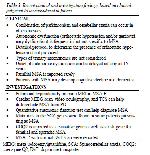In this study, we found that MSA patients are not accu-rately diagnosed especially in initial years where the symptoms start to manifest themselves. Only one in eleven patients followed-up had been accurately diag-nosed. This finding shows that there are diagnostic challenges throughout the clinical course of MSA, especially for patients who are followed-up in places other than centers specializing in movement disorders.
The accurate diagnosis of MSA is significant for ap-propriate patient management, particularly in early stages of the disease where the symptoms are not yet fully manifested. However, as far as early diagnosis goes, it is obvious that the existing clinical diagnostic criteria have certain challenges. In this context, it should be mentioned that up-to-date laboratory and clinical findings may contribute to the accuracy of the diagnosis
9.
Today, an increasing number of publications highlight the challenges in MSA diagnosis 9,10. Existing clin-ical diagnostic criteria used for MSA have various limitations. First of all, these criteria mostly focus on motor findings associated with the disease. Parkinson-ism and cerebellar ataxia non-responsive to L-dopa are not uncommon cases and may be observed in many disorders other than MSA 11,12. Secondly, auto-nomic deficiency and genitourinary dysfunction in particular are not specific to MSA. These may be ob-served in other neurodegenerative diseases and even in healthy individuals between the ages of 50-60 13,14. Thirdly, orthostatic hypotension may be seen in many cases other than MSA. For example, it is reported in a study that 20% of PD patients present orthostatic hypo-tension 15. The fourth limitation is that both auto-nomic deficiency and motor symptoms are necessary for MSA diagnosis. However, autonomic deficiency and motor symptoms do not develop concurrently in many MSA patients. While some patients present auto-nomic deficiency from the onset of the disease, some do not show any symptoms even after 15 years 16. Indeed, one of our patients (Table 2, case 11) had the symptoms for four years, yet did not present orthostatic hypotension to this day.
A considerable number of patients are not correctly diagnosed with MSA during their lifetime due to diffi-culties in differentiating it from other diseases. (PD, pure autonomic failure, other rare movement disor-ders). MSA may be accompanied by Parkinsonian symptoms quite frequently. About 10% of patients diagnosed with Parkinsons Disease are reported to have MSA at autopsy. About 29-33% of patients who present isolated late-onset cerebellar ataxia and 8-10% of patients with Parkinsonism develop MSA. For this reason, it is safe to assume a higher prevalence than estimations 17.
The EMSA registry study examined 437 patients diag-nosed with MSA. Sixty-eight percent of these patients were found to have symptoms that fit MSA-P and 32% were found to have symptoms that fit MSA-C. While 99% of the patients had autonomic deficiency symp-toms (urinary symptoms, orthostatic hypotension, and chronic constipation), 87% had Parkinsonism, 64% had ataxia, and 43% had pyramidal symptoms. Additional-ly, 41% of the patients showed signs of depression 10. As explained above, MSA may be manifested with different symptoms, and the clinical table may be heterogeneous, which causes diagnostic challenges for the clinician 18.
Imaging methods are frequently used for the clinically differential diagnosis of MSA. These methods include MRI, positron emission tomography (PET), and single photon emission computed tomography (SPECT). Issues related to nerve supply to heart may demonstrate an association with MSA or PD, which may be deter-mined using PET and SPECT scans. Also, it is not possible to exclude MSA due to normal dopamine transporter imaging. The hot cross bun sign is ob-served in 63% of MSA-P patients and 80% of MSA-C patients 17. This presentation may be observed in variant Creutzfeldt-Jakob disease, spinocerebellar atax-ia, cerebrotendinous xanthomatosis, and vasculitis-associated parkinsonism as well 19-21. In addition, it has been shown in a considerable number of studies that lateral slit-like hyperintense putaminal rim and putaminal hypointensity are observed more frequently on conventional brain MRIs of MSA patients compared to controls and PD patients 22,23.
It is recommended that clinicians pay attention to cer-tain characteristics to improve the accuracy of differen-tial MSA diagnosis 9. Table 3 shows these character-istics recommended for clinically differential diagnosis of MSA.

Büyütmek İçin Tıklayın |
Table 3: Recent clinical and investigation findings based on clinical judgment to be considered in future. |
The relatively low number of patients included in the study and lack of neuropathological examination of our MSA patients may be accepted as limitations of our study.



